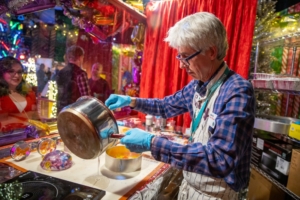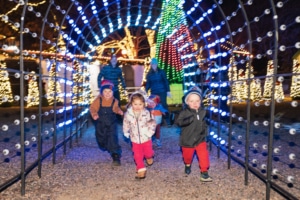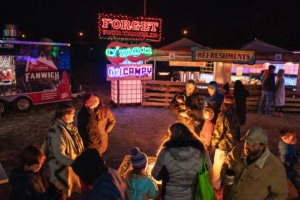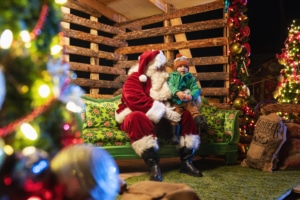DCPA NEWS CENTER
Enjoy the best stories and perspectives from the theatre world today.
Enjoy the best stories and perspectives from the theatre world today.
An annual holiday tradition, Camp Christmas has fascinated thousands of people with its quirky charm, nostalgia, and brilliant cheer. It’s a maze of holiday spirit, filled to bursting with sentimentality, decorations, enchanting art, and more. It’s a place to get lost and connect with your childhood memories. But where did all of those trinkets come from? And how on Earth do they all fit together in Camp Christmas?
Lonnie Hanzon, Denver-based artist and creator of Camp Christmas, walks us through his process — from his career beginnings as a performer to his attachment to all things Christmas.

Creator Lonnie Hanzon at Camp Christmas 2019. Photo by Adams VisCom.
DCPA: Where did you get your start? Why traverse into immersive theatre?
I started as a performer, a magician/clown type of performer. Soon, I was doing costumes and sets for other people. Then that led to retail and window design, window dressing. Which then led into what we would now call our first immersive art project in the mid-80s called 12/25: The Holiday Store. That was one of our first large Christmas projects. We did a lot of public art projects, and we’ve done the Wizard’s Chest Toy Store in Denver for the last 42 years.
Everything that we’ve worked on has been audience centric, whether I knew it at the time or not. I did anything I could to stay in the arts, we were taking every gig. It didn’t matter if it was a costume one minute and an interior the next. We were mixed media, not by choice, but by necessity. And when immersive rose as a term and as a form, we fit the bill. It is the definition of mixed media; it uses all the languages.

Camp Christmas. Photo by Amanda Tipton Photography
DCPA: How did Camp Christmas come to fruition?
I had met Charlie Miller [Executive Director & Curator of DCPA’s Off-Center] and we chatted about projects and agreed to stay in touch. I really wanted to get into the immersive world, never thinking it would be on the subject of Christmas. It was Charlie’s idea, what if we were to combine my massive Christmas collection with immersive theatre, and so Camp Christmas came to be in 2019.
DCPA: Speaking of your Christmas collection, Camp Christmas is filled to the brim with knick knacks, antiques, and art. And yet, it all works together. How do you take such a large theme and distill it into this cohesive experience?
Let’s just take the Pink Room at Camp Christmas. It came as an idea to me that pink is not just a color, but a place. I loved the idea of doing everything in pink. I don’t design everything on paper and then figure out a way to execute it. It’s curvilinear.
First, we do something called pulling palette. We collect, we buy, we go to every auction and estate sale, we glean, we forage. Sometimes we know what we’re foraging for, sometimes things just appear. We recycle from old shows. There are things we’ve used in Camp Christmas that were created by us in the 80’s, things we’ve found and bought back at auctions.

Camp Christmas. Photo by Amanda Tipton Photography
Then we bounce back and forth between technical and creative. It’s different than a lot of processes where there is an assembly line on the team. We don’t have a designer draw the idea, then an engineer execute it, and a painter paint it. We don’t work like that. The vision is usually there, but out of focus. In our process, the focus comes in. It’s tennis.
All of this collateral, the term we use for scenery pieces, props, costumes, all the materials, is then styled in the space.
DCPA: Without a clear plan to start, how do all of the pieces fit into the narrative of Camp Christmas?
Think of traditional theatre. The script is like a musical orchestration, a score. The script tells you: these are the characters, these are their lines, this is the setting – just like a score tells you the instruments, the speed, the order of the songs. This score is then handed to the musicians and they manifest those parts.
If you keep that in mind as traditional theatre, then imagine Camp Christmas as jazz. There is knowledge and a skill set, there’s some chords, but it isn’t written down. It’s bounced from musician to musician. It’s a round robin serving the narrative, serving the visual, serving the sound, serving all the components of an experience, to end up with something like Camp Christmas.

Camp Christmas. Photo by Amanda Tipton Photography.
DCPA: It sounds like there is a lot of collaboration involved.
There’s a lot of trust. I may have a vision or an idea, but it’s my job to communicate the whole of that as much as possible. And sometimes there simply aren’t enough hours in the day. All the creation is judged on whether it works for the whole – it’s not judged on what I thought it was going to look like. I always think ‘is it good,’ not, ‘is it mine.’
These projects are just so big, there has to be enormous autonomy among the creators. They want autonomy, they want to be masterful, and they want purpose. If we create an environment where the collaborators get those things, you’re going to end up with something pretty spectacular.
DCPA: Camp Christmas has grown over the years, going from Stanley Marketplace to a completely virtual experience during the pandemic to Heritage Lakewood Belmar Park. Now, you’re headed back to Stanley. How do you evolve?
We started at 10,000 square feet, and we poured ourselves into that one room at Stanley Marketplace. Then we moved to 13 buildings and 6 acres in Lakewood. We added an enormous amount of stuff.

Camp Christmas. Photo by Amanda Tipton Photography
Now we’re moving back from Lakewood to Stanley Marketplace. Just like every play or opera adapts to a new theatre, we’re doing the same thing. We’re in the same original space, but we’re also moving out into the hallways and the Stanley Beer Hall. There will be an outdoor Funky Forest Frolic, including Santa’s Glampsite, Ornament Grove, and the Doll House Village.
DCPA: What would you say to someone to encourage them to visit Camp Christmas?
It’s just a place where you get your holiday spirit on. You’re never going to see more Christmas decorations in one place in your life, I can pretty much guarantee that. There will be something there that will rekindle something from childhood, something from Grandma’s house, something that will help you reconnect with the holiday season. It’s not meant to be a stressful time of year; it’s meant to be joyful. So I encourage people to come remember that feeling, to fall in love with it again.
DCPA: What do you love about it?
I love catching a kid getting enchanted. It’s the nose-prints and the handprints. What a big payoff. Even for an older person, if I see something is rekindled or re-connected, that’s what I’m after. Christmastime for me saved my life. I want it to be a positive thing, to find a simple joy in what has become a very materialistic holiday. Even a hug, wrapped with love and joy, is a fabulous gift.
